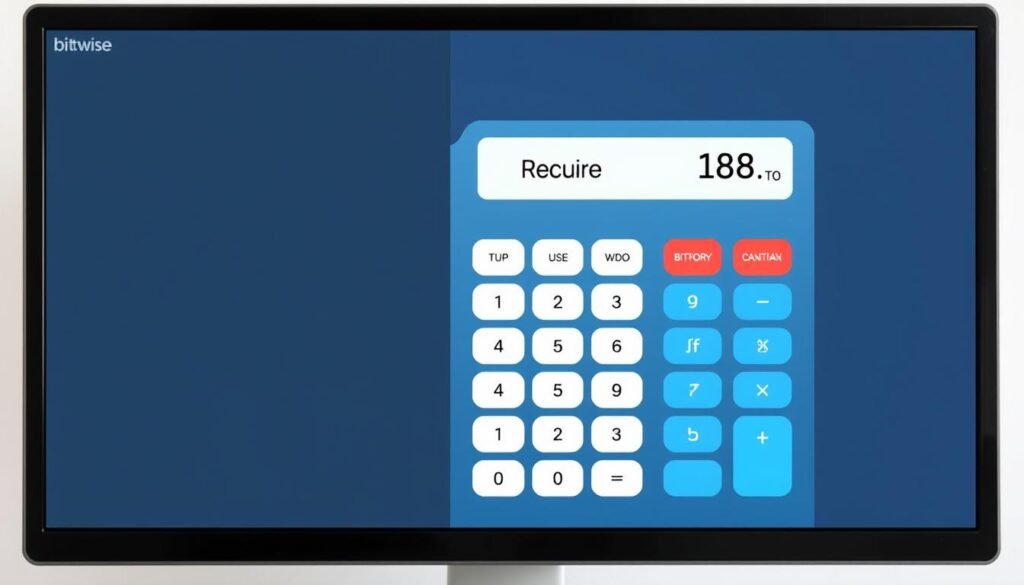Simplify Your Binary Calculations
Simplify complex binary calculations with our user-friendly Bitwise Calculator, available online for free. Our tool is designed to perform binary operations on numbers with ease and precision, supporting multiple number formats including binary, decimal, hexadecimal, and octal.
Our free online Bitwise Calculator is a powerful resource for anyone needing to perform binary operations. Whether you’re a beginner or a professional, this tool simplifies complex binary calculations, making it easier to work with different number systems.
The calculator supports various number formats, including binary, decimal, hexadecimal, and octal, catering to comprehensive calculation needs. This versatility makes it an indispensable tool for programming and computer science applications.
Understanding Bitwise Operations
Understanding how bitwise operations work requires a solid grasp of the binary system and the concept of bits. Bitwise operations are crucial in digital electronics and computing, serving as the foundation for more complex operations.
What Are Bits and Binary Numbers?
A bit is the smallest unit of information in digital communication and electronics, representing either 0 or 1. Bits are used to form binary numbers, which are based on the base-2 number system. In this system, each digit represents a power of 2. For example, the binary number 101 equals $1 \times 2^2 + 0 \times 2^1 + 1 \times 2^0 = 5$ in the decimal system.
To illustrate how binary numbers work, let’s look at a simple conversion table:
| Binary | Decimal |
|---|---|
| 000 | 0 |
| 001 | 1 |
| 010 | 2 |
| 011 | 3 |
| 100 | 4 |
| 101 | 5 |
Bits are combined to represent larger amounts of data; for instance, 8 bits form a byte, which equals $2^8 = 256$ different logical states.

The Fundamentals of Bitwise Logic
Bitwise logic involves operations that directly manipulate the individual bits of binary numbers. These operations are essential in low-level programming, encryption, and optimizing algorithms. The core bitwise operations include AND, OR, XOR, and NOT, each performing a specific logical operation on the bits.
For example, the bitwise AND operation compares each bit of the first operand to the corresponding bit of the second operand. If both bits are 1, the corresponding result bit is set to 1. Otherwise, the corresponding result bit is set to 0.
Our Free Online Bitwise Calculator

Simplify your bitwise calculations with our free online bitwise calculator. This powerful tool is designed to perform various bitwise operations across different number systems, making it an essential resource for both beginners and professionals.
Key Features and Benefits
Our calculator offers several key features that enhance its functionality and user experience. These include:
- Supports multiple number formats including binary, decimal, hexadecimal, and octal.
- Provides instant computation for all major bitwise operations like AND, OR, XOR, NOT, left shift, and right shift.
- Features a clean, intuitive interface designed for seamless calculations.
- Is completely free and accessible online without any downloads or registrations required.
- Ensures cross-platform compatibility, working equally well on desktops, tablets, and mobile devices.
Supported Number Formats
Our bitwise operation calculator supports a variety of number formats, making it a versatile converter for different numbering systems. You can perform operations on:
- Binary numbers
- Decimal numbers
- Hexadecimal values
- Octal numbers
This flexibility allows users to work with different data types and convert between them efficiently, making our calculator a valuable tool for various applications.
How to Use Our Bitwise Calculator
Our bitwise calculator is designed to simplify complex bitwise operations, making it an essential tool for developers and programmers. With its intuitive interface, you can easily perform various bitwise calculations.
Step-by-Step Guide
To use our bitwise calculator, follow these simple steps:
- Enter the first number and select its format (binary, decimal, hex, or octal).
- Choose the bitwise operation you want to perform from our comprehensive dropdown menu.
- Enter the second number and select its format, allowing for mixed format calculations.
- Click the “Calculate” button to get the results instantly, displayed in multiple formats.
- If needed, click the “Reset” button to clear all fields and start a new calculation.
Tips for Accurate Calculations
To ensure accurate calculations, verify your input formats, especially when working with different number systems. Start with simple operations if you’re new to bitwise calculations, and gradually move to more complex ones as you become familiar with the tool. Be aware of common pitfalls, such as confusion between mathematical and bitwise operators.
By following these tips and using our bitwise calculator, you can efficiently perform bitwise operations and achieve accurate results.
Supported Bitwise Operations
Our bitwise calculator supports a wide range of operations, making it a versatile tool for various binary calculations. This section will delve into the specifics of the bitwise operations supported by our calculator.
Basic Operations: AND, OR, XOR, and NOT
Our calculator includes fundamental bitwise operations such as AND (&), OR (|), XOR (^), and NOT (~). The AND operation compares corresponding bits of two numbers, outputting 1 only when both input bits are 1. For example, 5 (101) & 3 (011) = 1 (001). The OR operation returns 1 if at least one of the compared bits is 1, as seen in 5 (101) | 3 (011) = 7 (111). The XOR operation outputs 1 only when exactly one of the compared bits is 1, illustrated by 5 (101) ^ 3 (011) = 6 (110). Lastly, the NOT operation inverts all bits, changing 0s to 1s and 1s to 0s, such as ~5 (00000101) becoming (11111010) in 8-bit representation.
These basic operations are crucial for binary calculations and are widely used in programming and computer science applications.

Shift Operations and Mathematical Functions
In addition to basic bitwise operations, our calculator also supports shift operations and various mathematical functions. Left Shift ( and Right Shift (>>) are two primary shift operations. Left Shift effectively multiplies the number by 2 for each position shifted, as seen in 5 (101) > 1 = 2 (10).
Our calculator also supports standard mathematical operations in binary, including addition, subtraction, multiplication, division, and power functions. For instance, you can perform addition like 5 (101) + 3 (011) = 8 (1000), or multiplication like 5 (101) × 3 (011) = 15 (1111). These operations are essential for various binary arithmetic tasks.
Practical Applications of Bitwise Operations
From optimizing code to securing data, bitwise operations play a crucial role in many modern technological advancements. These operations are not just theoretical concepts; they have numerous practical applications across various fields.
Computer Science and Programming
In computer science and programming, bitwise operations serve as building blocks for efficient algorithms and data structures. They are used to optimize code performance, particularly in resource-constrained environments like embedded systems. Programmers leverage bitwise operations to enhance the efficiency of their code, making it more suitable for environments where resources are limited.
Real-World Uses in Technology
Bitwise operations have various real-world applications in technology, including computer graphics, cryptography, and networking. They are used in data compression to reduce file sizes while maintaining data integrity. Additionally, bitwise operations are crucial in cryptography for securing data through encryption algorithms. Our bitwise calculator can be a valuable tool for developers working with these technologies, helping them perform complex bitwise operations with ease.

Conclusion
Ultimately, our bitwise calculator stands out as a valuable tool for anyone working with binary systems. We’ve provided a comprehensive overview of its capabilities, from basic bitwise operations to advanced shift functions and mathematical calculations. This calculator serves as both an educational resource and a practical utility for professionals. We continuously update our calculators, including binary, decimal, and octal converters, to ensure accuracy and performance. We welcome your feedback to further improve our bitwise calculator.
FAQ
What is the purpose of a bitwise operation?
We use bitwise operations to perform actions on the binary representations of numbers, which is useful in various programming and computational tasks.
How do I convert decimal numbers to binary using our tool?
Our bitwise operation tool supports decimal to binary conversion. Simply input the decimal number, and it will be converted to its binary equivalent.
Can I perform shift operations using our bitwise operation tool?
Yes, we support shift operations, including left shift and right shift, which are essential in various bitwise calculations.
What number formats are supported by our bitwise operation tool?
We support various number formats, including binary, decimal, and hexadecimal, making it easy to work with different data representations.
How do I use the XOR operation in our bitwise operation tool?
To use the XOR operation, simply select the XOR option and input the required numbers. Our tool will then perform the XOR operation and display the result.
Are the results from our bitwise operation tool accurate?
Yes, our tool is designed to provide accurate results for various bitwise operations, ensuring reliable output for your computational needs.
Can I use our bitwise operation tool for gray code conversions?
Yes, we support gray code conversions, which can be useful in certain applications, such as error detection and correction.
Is our bitwise operation tool free to use?
Yes, our bitwise operation tool is completely free to use, making it a valuable resource for anyone working with bitwise operations.

